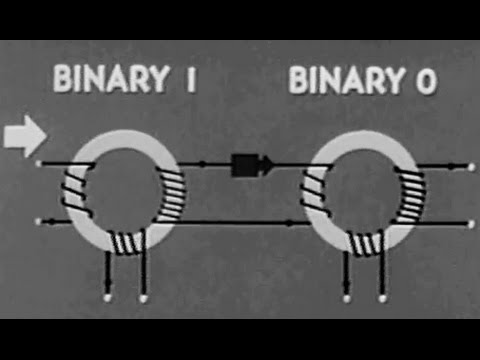more at
Introduction to magnetic core memory.
“PROPERTIES OF MAGNETIC CORES AND THEIR APPLICATION IN DATA PROCESSING SYSTEM; HOW INFORMATION IS STORED AND TRANSFERRED FROM ONE CORE TO ANOTHER.”
US Army Training Film TF11-3131.
Magnetic Cores II: Basic Circuits:
Electronics playlist:
Public domain film from the Prelinger Archives, slightly cropped to remove uneven edges, with the aspect ratio corrected, and mild video noise reduction applied.
The soundtrack was also processed with volume normalization, noise reduction, clipping reduction, and/or equalization (the resulting sound, though not perfect, is far less noisy than the original).
Magnetic-core memory was the predominant form of random-access computer memory for 20 years (circa 1955–75). It uses tiny magnetic toroids (rings), the cores, through which wires are threaded to write and read information. Each core represents one bit of information. The cores can be magnetized in two different ways (clockwise or counterclockwise) and the bit stored in a core is zero or one depending on that core’s magnetization direction. The wires are arranged to allow an individual core to be set to either a “one” or a “zero”, and for its magnetization to be changed, by sending appropriate electric current pulses through selected wires. The process of reading the core causes the core to be reset to a “zero”, thus erasing it. This is called destructive readout.
Such memory is often just called core memory, or, informally, core. Although core memory had been superseded by semiconductor memory by the end of the 1970s, memory is still occasionally called “core”; in particular, a file recording the contents of memory after a system error is usually called a core dump…
The basic concept of using the square hysteresis loop of certain magnetic materials as a storage or switching device was known from the earliest days of computer development. Much of this knowledge had developed due to an understanding of transformers, which allowed amplification and switch-like performance when built using certain materials. The stable switching behavior was well known in the electrical engineering field, and its application in computer systems was immediate…
Substantial work in the field was carried out by the Shanghai-born American physicists An Wang and Way-Dong Woo…
Several researchers in the late 1940s, including Jay Forrester, conceived the idea of using magnetic cores for computer memory, but Forrester received the principal patent for his invention of the coincident core memory that enabled the 3D storage of information. William Papian of Project Whirlwind cited one of these efforts, Harvard’s “Static Magnetic Delay Line”, in an internal memo. The first core memory of 32 x 32 x 16 bits was installed on Whirlwind in the summer of 1953…
A third developer involved in the early development of core was Jan A. Rajchman at RCA…
The most common form of core memory, X/Y line coincident-current, used for the main memory of a computer, consists of a large number of small toroidal ferromagnetic ceramic ferrites (cores) held together in a grid structure (organized as a “stack” of layers called planes), with wires woven through the holes in the cores’ centers. In early systems there were four wires: X, Y, Sense, and Inhibit, but later cores combined the latter two wires into one Sense/Inhibit line. Each toroid stored one bit (a 0 or 1). One bit in each plane could be accessed in one cycle, so each machine word in an array of words was spread over a “stack” of planes. Each plane would manipulate one bit of a word in parallel, allowing the full word to be read or written in one cycle…
To read a bit of core memory, the circuitry tries to flip the bit to the polarity assigned to the 0 state, by driving the selected X and Y lines that intersect at that core.
– If the bit was already 0, the physical state of the core is unaffected.
– If the bit was previously 1, then the core changes magnetic polarity. This change, after a delay, induces a voltage pulse into the Sense line.
The detection of such a pulse means that the bit had most recently contained a 1. Absence of the pulse means that the bit had contained a 0. The delay in sensing the voltage pulse is called the access time of the core memory.
Following any such read, the bit contains a 0. This illustrates why a core memory access is called a destructive read: Any operation that reads the contents of a core erases those contents, and they must immediately be recreated…

